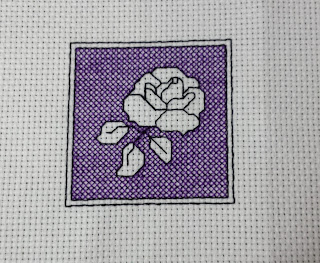I don't participate in all guild activities, but I try to at least attend the Tuesday evening stitching and the monthly guild meeting. This month's meeting had a talk about Assisi Embroidery. We were given some patterns, a piece of fabric, some DMC black and another color of our choice. I'm on a purple kick right now so that's what I picked.
When I went home I did a quick search for all the things that were presented and found a few links that would be of interest:
I confess I quite like this type of embroidery. Assisi Embroidery is stitched in two steps. The outline is stitched first with 1 strand of black in Holbein stitch (check out this link for an excellent tutorial on holbein stitch by Ajisai Press). Once the outline is finished, the background is filled with cross stitch using 1 strand of another color. This is the type of stitching I would take on a trip, once all the outline has been stitched.
Now if you've been tempted with all the nice pictures as I have, I managed to track down the patterns to stitch them :) You can buy most of these from this website (I quite like the pillow) or you can track down a copy of Thérèse de Dillmont's 1920 Assisi Embroideries which I've already done for you here (look for the word 'assisi' and you'll be able to download part 1 and 2).
Dillmont's book contains clear images of the designs which you'll have to turn into a pattern. Luckily Pinoy Stitch exists. They've already done all the pre-work so all you need to do is download and start stitching :)
Update: I found another link that describes how to do the Rolled Hem that's used to finish Assisi Embroidery. The tutorial is by Jeanine, her website covers all the different types of Italian embroidery. You'll notice that most of it is whitework :P
When I went home I did a quick search for all the things that were presented and found a few links that would be of interest:
I confess I quite like this type of embroidery. Assisi Embroidery is stitched in two steps. The outline is stitched first with 1 strand of black in Holbein stitch (check out this link for an excellent tutorial on holbein stitch by Ajisai Press). Once the outline is finished, the background is filled with cross stitch using 1 strand of another color. This is the type of stitching I would take on a trip, once all the outline has been stitched.
Now if you've been tempted with all the nice pictures as I have, I managed to track down the patterns to stitch them :) You can buy most of these from this website (I quite like the pillow) or you can track down a copy of Thérèse de Dillmont's 1920 Assisi Embroideries which I've already done for you here (look for the word 'assisi' and you'll be able to download part 1 and 2).
Dillmont's book contains clear images of the designs which you'll have to turn into a pattern. Luckily Pinoy Stitch exists. They've already done all the pre-work so all you need to do is download and start stitching :)
Update: I found another link that describes how to do the Rolled Hem that's used to finish Assisi Embroidery. The tutorial is by Jeanine, her website covers all the different types of Italian embroidery. You'll notice that most of it is whitework :P

Beautiful. I"ve always loved Assisi embroidery. Thank you for the refresher and the links.
ReplyDeletehugs
xxx
Beautiful. I have never heard of it.
ReplyDeleteLinda
Yes, Assisi work does have a charming effect, doesn't it. One of those examples of simplicity working particularly well....
ReplyDelete♥beautiful♥
ReplyDeleteI like the look of Assisi, but so far no real urge to try it. Great colour choice.
ReplyDeleteThank you so much for including all of the fabulous links to everything, it is so appreciated <3
ReplyDeleteAssisi work is lovely. I like something that turns an idea on its head to make a very different look.
ReplyDeleteIt´s ages since I´ve done any Assisi embroidery, this design is lovely and am off to follow the links. thank you.
ReplyDelete